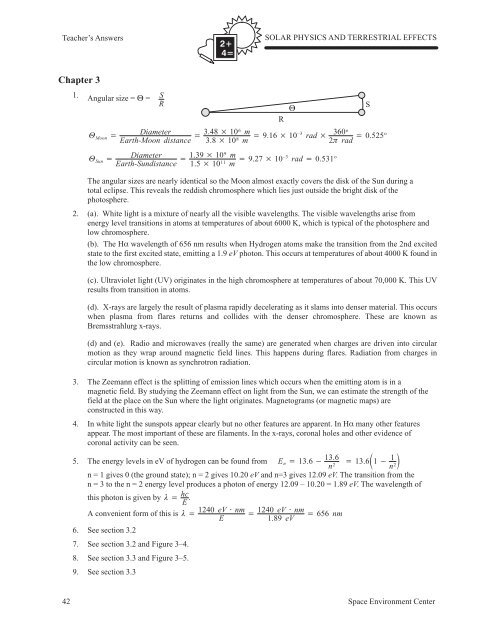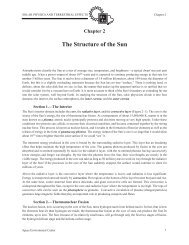Answers to Chapter Questions - Space Environment Center
Answers to Chapter Questions - Space Environment Center
Answers to Chapter Questions - Space Environment Center
Create successful ePaper yourself
Turn your PDF publications into a flip-book with our unique Google optimized e-Paper software.
Teacher’s <strong>Answers</strong><br />
<br />
<br />
SOLAR PHYSICS AND TERRESTRIAL EFFECTS<br />
<strong>Chapter</strong> 3<br />
1.<br />
Angular size = =<br />
Moon <br />
Sun <br />
S<br />
R<br />
Diameter<br />
Earth-Moon distance 3.48 106 m<br />
3.8 10 8 m 9.16 10–3 rad 360o<br />
2 rad 0.525o<br />
Diameter<br />
Earth-Sundistance 1.39 109 m<br />
1.5 10 11 m 9.27 10–3 rad 0.531 o<br />
The angular sizes are nearly identical so the Moon almost exactly covers the disk of the Sun during a<br />
<strong>to</strong>tal eclipse. This reveals the reddish chromosphere which lies just outside the bright disk of the<br />
pho<strong>to</strong>sphere.<br />
2. (a). White light is a mixture of nearly all the visible wavelengths. The visible wavelengths arise from<br />
energy level transitions in a<strong>to</strong>ms at temperatures of about 6000 K, which is typical of the pho<strong>to</strong>sphere and<br />
low chromosphere.<br />
(b). The H wavelength of 656 nm results when Hydrogen a<strong>to</strong>ms make the transition from the 2nd excited<br />
state <strong>to</strong> the first excited state, emitting a 1.9 eV pho<strong>to</strong>n. This occurs at temperatures of about 4000 K found in<br />
the low chromosphere.<br />
(c). Ultraviolet light (UV) originates in the high chromosphere at temperatures of about 70,000 K. This UV<br />
results from transition in a<strong>to</strong>ms.<br />
(d). X-rays are largely the result of plasma rapidly decelerating as it slams in<strong>to</strong> denser material. This occurs<br />
when plasma from flares returns and collides with the denser chromosphere. These are known as<br />
Bremsstrahlurg x-rays.<br />
(d) and (e). Radio and microwaves (really the same) are generated when charges are driven in<strong>to</strong> circular<br />
motion as they wrap around magnetic field lines. This happens during flares. Radiation from charges in<br />
circular motion is known as synchrotron radiation.<br />
3. The Zeemann effect is the splitting of emission lines which occurs when the emitting a<strong>to</strong>m is in a<br />
magnetic field. By studying the Zeemann effect on light from the Sun, we can estimate the strength of the<br />
field at the place on the Sun where the light originates. Magne<strong>to</strong>grams (or magnetic maps) are<br />
constructed in this way.<br />
4. In white light the sunspots appear clearly but no other features are apparent. In H many other features<br />
appear. The most important of these are filaments. In the x-rays, coronal holes and other evidence of<br />
coronal activity can be seen.<br />
5. The energy levels in eV of hydrogen can be found from E n 13.6 13.6 13.61 1 <br />
n 2<br />
n 2<br />
n = 1 gives 0 (the ground state); n = 2 gives 10.20 eV and n=3 gives 12.09 eV. The transition from the<br />
n = 3 <strong>to</strong> the n = 2 energy level produces a pho<strong>to</strong>n of energy 12.09 – 10.20 = 1.89 eV. The wavelength of<br />
this pho<strong>to</strong>n is given by hc<br />
E .<br />
A convenient form of this is <br />
1240 eV nm<br />
<br />
1240 eV nm<br />
656 nm<br />
E<br />
1.89 eV<br />
6. See section 3.2<br />
7. See section 3.2 and Figure 3–4.<br />
8. See section 3.3 and Figure 3–5.<br />
9. See section 3.3<br />
R<br />
<br />
S<br />
42 <strong>Space</strong> <strong>Environment</strong> <strong>Center</strong>



